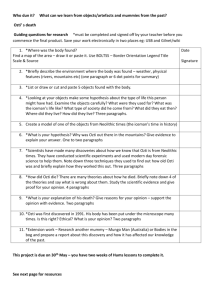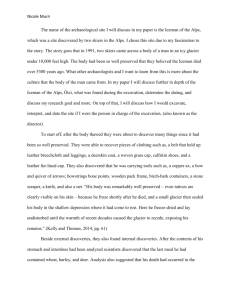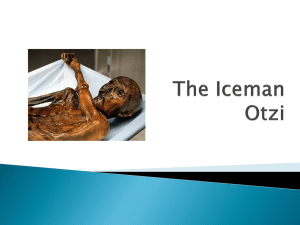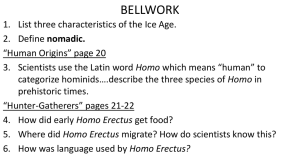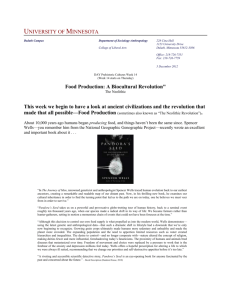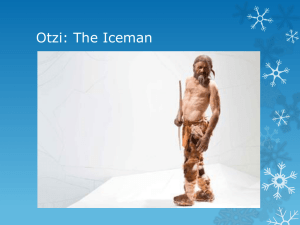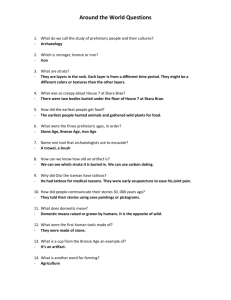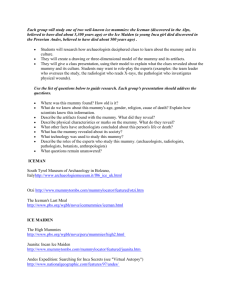Non-Fiction - LEUSD Tech
advertisement
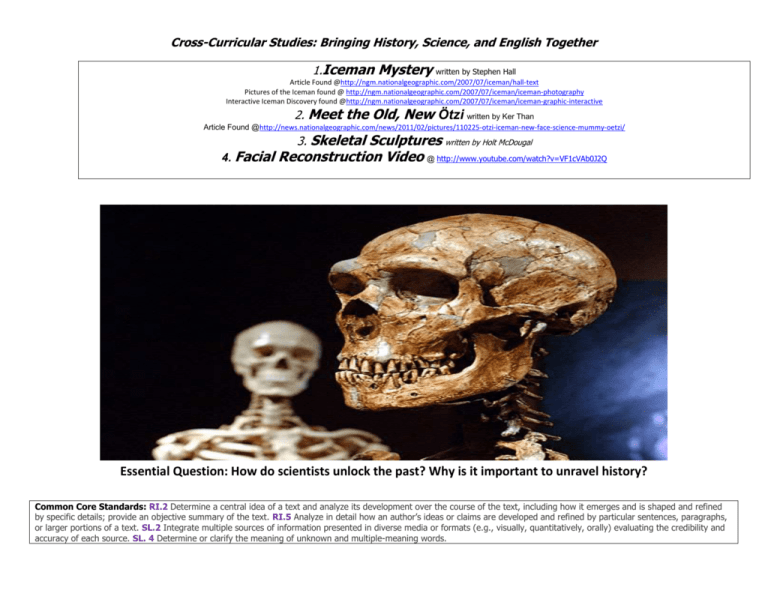
Cross-Curricular Studies: Bringing History, Science, and English Together Iceman Mystery 1. written by Stephen Hall Article Found @http://ngm.nationalgeographic.com/2007/07/iceman/hall-text Pictures of the Iceman found @ http://ngm.nationalgeographic.com/2007/07/iceman/iceman-photography Interactive Iceman Discovery found @http://ngm.nationalgeographic.com/2007/07/iceman/iceman-graphic-interactive Meet the Old, New Ötzi 2. written by Ker Than Article Found @http://news.nationalgeographic.com/news/2011/02/pictures/110225-otzi-iceman-new-face-science-mummy-oetzi/ 4. Facial 3. Skeletal Sculptures written by Holt McDougal Reconstruction Video @ http://www.youtube.com/watch?v=VF1cVAb0J2Q Essential Question: How do scientists unlock the past? Why is it important to unravel history? Common Core Standards: RI.2 Determine a central idea of a text and analyze its development over the course of the text, including how it emerges and is shaped and refined by specific details; provide an objective summary of the text. RI.5 Analyze in detail how an author’s ideas or claims are developed and refined by particular sentences, paragraphs, or larger portions of a text. SL.2 Integrate multiple sources of information presented in diverse media or formats (e.g., visually, quantitatively, orally) evaluating the credibility and accuracy of each source. SL. 4 Determine or clarify the meaning of unknown and multiple-meaning words. Introduction: While it’s true that corpses and skeletons can’t talk, they can still tell us a great deal of important information about the past. As you probably know from watching popular true-crime shows or fictional crime thrillers, human remains often have their own story to share. As detectives unravel complicated cases, crime scene investigators expose invisible truths, and scientists investigate unexplained phenomena, human remains often tell stories that help piece the past together. Make the Connection: With a group of peers discuss the type of criminal or scientific investigations you are familiar with. Create a list of methods investigators and scientists use to find and expose the truth. Next, briefly explain the purpose of each method as you understand it. 1. Method Fingerprinting Purpose Used to identify the person Analyzing the Text: Text Features Text features are design elements that highlight the organization and key information of a text. They are very useful as you preview, read, and try to determine the central idea of a text. Here are some helpful text features: Numbered Lists: Such lists often include steps in a process that should be followed in order Subheadings: These headings serve as a signal of the beginning or a new topic or section. They often identify the focus of the text that follows after them. Graphic Aids/Visuals: Visuals and graphic aids, such as maps, charts, and photographs, communicate information visually to the reader. They are commonly accompanied by captions, which describe and/or clarify the information. As you read the selections, use the text features to help you analyze how claims and ideas are developed in each article. Strategies for Reading: Taking Notes When you take notes, your primary goal should be to summarize the text’s claims, central or main ideas, and details in a way that is easy to under understand and recall. Remember that text features highlight central ideas and key information, so adding them to your notes can be helpful. -As you read each section of “Who Killed the Iceman?” write down the subheadings and record the critical information included in each section. -As you read “Skeletal Sculptures,” note the key information in each step. A terrific and highly effective way to take notes is the Cornell Note-taking process. Look at the example template below and view the video or PowerPoint to learn more about this excellent method for taking notes. Tutorial Video for Cornell Notes- http://www.youtube.com/watch?v=jlaZAviZXvM (13.5 minutes) or http://www.youtube.com/watch?v=WtW9IyE04OQ (6 minutes) PowerPoint Directions: http://schools.birdvilleschools.net/page/2166 Find a Cornell Note Template for Word @ http://schools.birdvilleschools.net/page/2166 Cornell Notes Topic/Objective: Essential Question: Questions: Summary: Notes: Questions: Notes: Vocabulary in Context Directions: From the word list, choose a word that could replace the bolded word in each newspaper heading. 1. 2. 3. 4. 5. Woman Thought Guilty of Bank Robbery New Study from Harvard to Pull Together Years of Research Strange Object found on Ocean Floor Science Focus: Native American Tribes Renowned Scholar to Deny Accuracy of Theory Word List: Refute Compile Presumed Artifact Anthropology Background to the Readings Unexpected Discoveries “Iceman Mystery” and “Meet the New, Old Ötzi” report some of the theories surrounding the death of a man who met his demise around 3000 B.C. The “Iceman,” is the oldest frozen mummy every found. While vacationing in the Alps, German hikers detected a body implanted in the ice. They assumed they’d stumbled onto a mountain climber who had died while hiking; they had no idea that they had just discovered a 5000-year-old relic! The Iceman (Ötzi) now resides at the South Tyrol Museum of Archaeology in Bolzano, Italy. The Iceman, seen here with a rescue worker, was discovered in 1991. Crime-Fighting Scientists “Skeletal Sculpture” and The Facial Reconstruction video describe how forensic anthropologists help police track down the truth. Anthropology is the scientific study of human beings – our origins, behavior, environment, and physical features. Forensics is the science used to solve crimes. Forensic anthropologists use their knowledge of human characteristics to help in cracking difficult cases that involve human remains. The scientists identify the victim’s age, gender, race, and physical characteristics. They can also help determine the likely cause of death, which makes them an integral member of a murder investigation team. If this topic interests you, read more about forensic anthropology @ FBI PAGE ON FORENIC ANTHROPOLOGY: http://www.fbi.gov/fun-games, FEMALE SPIES THROUGHOUT HISTORY from the National Women’s History Museum: http://www.nwhm.org/online-exhibits/spies/1.htm PBS PAGE (includes awesome cross-curricular lesson plans): http://www.pbs.org/opb/historydetectives/technique/forensic-anthropology/ , NATIONAL BOARD ON FORENSIC SCIENTISTS (Find careers!) http://www.theabfa.org/ , BOSTON UNIVERSITY’S Degree in Forensic Anthropology (go to college and become a forensic scientist!): http://www.bumc.bu.edu/gms/forensicanthro-masters-program/, TEXT #1: A Close Read “Iceman Mystery” from The National Geographic By Stephen S. Hall Article Found @http://ngm.nationalgeographic.com/2007/07/iceman/hall-text Pictures of the Iceman found @ http://ngm.nationalgeographic.com/2007/07/iceman/iceman-photography Interactive Iceman Discovery found @http://ngm.nationalgeographic.com/2007/07/iceman/iceman-graphic-interactive Update (September, 2007): Researchers report that head trauma along with uncontrolled bleeding ultimately killed the Close Read Iceman. Read more. Text Features: Examine this photograph and its accompanying caption. Does the 5,000-yearold mummy look as you expected him to, or does his appearance surprise you? Explain your answer. The Iceman was found in 1991 by unsuspecting hikers, who used makeshift tools to help free the mummy. Background It was late spring or early summer, when a modest tree called the hop hornbeam unfurls bright yellow clusters of flowers in the steep valleys that run north into the mountains now known as the Italian Alps. The man hurried through a forest he knew well, wincing from the pain in his injured right hand and pausing occasionally to listen for sounds that he was being pursued. As he fled up the slope, the yellow pollen of the hornbeam blossoms fell like an invisible rain, salting the water and food he consumed when he stopped to rest. Five thousand years later, the Neolithic hunter we call the Iceman would still bear traces of this ancient dusting inside his body—a microscopic record of the time of year it was when he passed through this forest and into the nearby mountains, where fate would finally catch up with him. Since hikers discovered his mummified corpse in 1991 in a rocky hollow high in the Ötztal Alps on Italy's border with Austria, scientists have used ever more sophisticated tools and intellectual cunning to reconstruct the life and times of the Iceman (or "Ötzi"), the oldest intact member of the human family. There are several artifacts to consider. We know that he was a small, What is the most important information from the sectioned titled “Background”? Be sure to record each section’s essential details in your Cornell notes. sinewy, and, for his times, rather elderly man in his mid-40s. Judging from the precious, copper-bladed ax found with him, we suspect that he was a person of considerable social significance. He set off on his journey wearing three layers of garments and sturdy shoes with bearskin soles. He was well equipped with a flint-tipped dagger, a little fire-starting kit, and a birchbark container holding embers wrapped in maple leaves. Yet he also headed into a harsh wilderness curiously under-armed: The arrows in his deerskin quiver were only half finished, as if he had recently fired all his munitions and was in the process of hastily replenishing them. And he was traveling with a long, roughly shaped stalk of yew—an unfinished longbow, yet to be notched and Artifact (noun) something created by humans, usually for practical purposes. strung. Why? The Iceman’s Shoe found at body site, a helpful artifact in determining his origins. New Information When it comes to the Iceman, there has never been a shortage of questions, or theories to answer them. During the 16 years that scientists have poked, prodded, incised, and x-rayed his body, they have dressed him up in speculations that have not worn nearly as well as his rustic garments. At one time or another, he has been mistakenly described as a lost shepherd, a shaman, a victim of ritual sacrifice, and even a vegan. But all these theories fade in the face of the most startling new fact scientists have learned about the Iceman. Although we still don't know exactly what happened up there on that alpine ridge, we now know that he was murdered, and died very quickly, in the rocky hollow where his body was found. "Even five years ago, the story was that he fled up there and walked around in the snow and probably died of exposure," said Klaus Oeggl, an archaeobotanist at the University of Innsbruck. "Now it's all changed. It's more like a paleo crime scene." Ötzi was found at approximately 10,500 feet in the Otztal Alps on the border between Austria and Italy. After closely examining Iceman’s clothing and possessions-including a sheath and dagger-archaeologists realized that he was over 5000-years-old. The object of all this intense scientific attention is a freeze-dried slab of human jerky, which since 1998 has resided in a refrigerated, high-tech chamber in the South Tyrol Museum of Archaeology in Bolzano, Italy. The temptation to conduct fresh Common Core SL. 2 Graphic Sources Examine the map that accompanies this article. Graphic sources such as maps clarify information in the text and present additional factual data. What information des this map convey? List two details you learn from the graphic source. experiments on the body rises with every new twist of technology, each revealing uncannily precise details about his life. Using a sophisticated analysis of isotopes in one of the Iceman's teeth, for example, scientists led by Wolfgang Muller (now at the Royal Holloway, University of London) have shown that he probably grew up in the Valle Isarco, an extensive north-south valley that includes the modern-day town of Bressanone. Isotope levels in his bones, meanwhile, match those in the soil and water of two alpine valleys farther west, the Val Senales and the Val Venosta. Muller's team has also analyzed microscopic chips of mica recovered from the Iceman's intestines, which were probably ingested accidentally in food made from stone-ground grain; geologic ages of the mica best match a small area limited to the lower Val Venosta. The Iceman probably set off on his final journey from this very area, near where the modern-day Adige and Senales Rivers meet. We also know that he was not in good health when he headed up into the mountains. The one surviving fingernail recovered from his remains suggests that he suffered three episodes of significant disease during the last six months of life, the last bout only two months prior to his death. Doctors inspecting the contents of his intestines have found eggs of the whipworm parasite, so he may well have suffered from stomach distress. But he was not too sick to eat. In 2002, Franco Rollo and colleagues at the University of Camerino in Italy analyzed tiny amounts of food residue from the mummy's intestines. Photograph by Robert Clark Near the Iceman's knee, a cross-shaped tattoo still stands out on his leathery skin. It may have been a folk remedy for arthritic joint pain. Iceman had more than 50 tattoos. A day or two before his death, the Iceman had eaten a piece of wild goat and some plant food. The same analysis revealed that his very last meal was red deer and some cereals. The archaeobotanist Klaus Oeggl has concluded from bran-like food residues that the Iceman's diet also included the primitive form of wheat known as einkorn as well as barley, found on his garments, indicating that the Neolithic settlements south of the Alps where he lived cultivated these grains. Oeggl has even found that the small size of Does it surprise you that even humans 5000 years ago tattooed their bodies? Why or why not? Explain. the wheat fragments in the gut, along with tiny flecks of charcoal, suggest that the grains were ground and then baked as primitive bread in open fires. Archaeobotanists have used equally clever analyses of pollen and plant fragments to plot the Iceman's last movements. James Dickson of the University of Glasgow has identified no less than 80 distinct species of mosses and liverworts in, on, or near the Iceman's body. The most prominent moss, Neckera complanata,still grows at several sites in the valleys to the south, in some cases quite near known prehistoric sites. According to Dickson, a clot of stems found in the Iceman's possession suggests he was probably using the moss to wrap food, although other ancient peoples used similar mosses as toilet paper. Taken together, the evidence strongly indicates that the Iceman's last journey began in the low-altitude deciduous forests to the south, in the springtime when the hop hornbeams were in bloom. But it may not have been a straight hike into the mountains. Oeggl has also found traces of pine pollen in the Iceman's digestive tract, both above and below the hornbeam pollen. This suggests that he may have climbed to a higher altitude where pine trees grow in mixed coniferous forests, then descended to the lower altitude of the hop hornbeams, and finally ascended again into the pine forests in his last day or two. Why? No one knows. But perhaps he wanted to avoid the steep, thickly wooded gorge of the lower Val Senales—especially if he was in a hurry. When he reached a mountain pass now known as Tisenjoch, he likely paused to rest. He had completed a vertical climb of 6,500 feet (2,000 meters) from the valley below, and to the north faced a desolate, glacier-riven landscape. Perhaps the rocky hollow where he found himself offered some shelter from the wind. We do not know if his enemies caught up with him at that spot, or were waiting there in ambush for him to arrive. What we do know is that he never left that hollow alive. Although the most important piece in the Iceman's equipment is a copper-bladed axe (tests have shown it could have chopped down a yew tree in 35 minutes) this stone disc is the most mysterious. Made of white Dolomite marble, it has a hole in the middle through which a hide strip was threaded. Nine twisted hide thongs were tied on to a loop in this strip. After 20 years, the disc's function remains unclear. Clues Uncovered In June 2001, Paul Gostner, director of the Department of Radiology at the Central Hospital in Bolzano, brought a portable xray machine to the Iceman's chamber. His intent was to prepare for a routine analysis of some broken ribs. The following day he dropped by the office of Eduard Egarter Vigl, director of the Institute of Pathology at the hospital and principal caretaker of the mummy, to report that the rib fractures were old and of limited interest. "But I've found another thing that I can't explain," he said. "There is this strange extraneous object in the left shoulder." When he compared his recent x-rays (and CT scans taken three months earlier) of the Iceman's torso with earlier films taken by scientists in Innsbruck, Gostner managed to detect what his Austrian colleagues had missed: a dense triangular shadow smaller than a quarter and lodged beneath the Iceman's left shoulder blade. It turned out to be a stone arrowhead. This "casual discovery," as Egarter Vigl put it, instantly turned an inexplicable death more than 5,000 years ago into archaeology's most fascinating cold case. The forensic evidence became even more intriguing in 2005, shortly after the hospital in Bolzano acquired a new highresolution multi-slice CT scanning machine. Gostner, Egarter Vigl, Patrizia Pernter, a physician in the Department of Radiology, and Frank Rühli, a doctor and senior lecturer in anatomy at the University of Zürich, decided to take a closer look at the body with the new CT machine. In August 2005, doctors placed the Iceman on a custom-built foam mattress, covered him with an insulated blanket and heaps of ice, and rushed him by ambulance (with a police escort) on the ten-minute ride from the museum to the hospital. There, with the kind of urgency usually reserved for humans in critical condition, they whisked the mummy into the scanning suite and quickly took a series of scans. "You had to do it before he thawed," Rühli noted, "so you had to hurry." The results were astonishing. The sharpened piece of stone, probably flint, had made a half-inch gash in the Iceman's left subclavian artery. This is the main circulatory pipeline carrying fresh oxygenated blood from the pumping chamber of the heart to the left arm. Such a serious tear in a major thoracic artery would almost certainly lead to uncontrolled bleeding and rapid death. "This is a lethal wound," Rühli says. "It was pretty quick. With this kind of bleeding, you don't go walking uphill for hours." Though no arrow shaft protrudes from the wound, and no blood marks the arrows entrance, it is now clear the Iceman was shot in the back. Language: Roots and Affixes A prefix is an affix (word part) added before a root or base word. One meaning of the prefix pro- is “forward.” What do you think protrudes in bold means? (Clue: the root –trud means “thrust.”) Check your answer in a dictionary. Text Features: How do these photographs support the central idea of the “Clues Uncovered” section? Explain, citing details from the text and photos. X-Ray Vision: It was not until scientist performed a CT-scan- a type of 3-D X-ray- that they saw the arrowhead buried in the Iceman’s shoulder blade. This new medical evidence suggests that an attacker, positioned behind and below his victim, fired a single arrow that struck the Iceman's left shoulder blade—precisely the area at which prehistoric hunters aimed to bring down game with one shot. The arrow went clean through the bone and pierced the artery. Blood instantly began to gush out, filling the space between the shoulder blade and the ribs. In his few remaining minutes of life, the Iceman became a textbook case of what is now known as hemorrhagic shock. His heart started to race. Sweat drenched his garments, even at an altitude two miles (three kilometers) above sea level. He felt increasingly faint because not enough oxygen was reaching his brain. In a matter of a few minutes, the Iceman collapsed, lost consciousness, and bled out. Then, in a fantastically fortunate cascade of circumstance, the brutal weather of the Ötztal Alps conspired with chance to perform one of the greatest embalming jobs in the history of human remains. The frigid glacial environment eventually tucked him in like a cold, wet blanket, immobilizing and preserving his body in snow, ice, and glacial meltwater. The little ravine protected his lifeless form from the bone-grinding action of the Niederjoch Glacier, which passed just a few feet overhead for the next 5,300 years. Remaining Questions and Theories Who killed the Iceman, and why? Was this a Neolithic version of highwaymen ambushing a hunter and snatching his catch? Or Take Notes: As you being reading the section about the different theories of Iceman’s death, take careful notes to keep track them. was he stalked and killed by a person, or persons, who knew him? Experts now believe that the mystery may hinge on a bizarre detail of the crime scene. The shaft of the fatal arrow was nowhere to be found. Someone must have pulled it out, leaving behind the stone arrowhead lodged in his body. "I believe—in fact, I am convinced—that the person who shot the Iceman with the arrow is the same person who pulled it out," says Egarter Vigl. In an article that appeared this May in the German archaeology magazine Germania, Egarter Vigl and his colleagues noted that telltale markings in the construction of prehistoric arrows could be used to identify the archer much in the way that modern-day ballistics can link a bullet to a gun. They argue that the Iceman's killer yanked out the arrow shaft precisely to cover his tracks. For similar motives, Egarter Vigl reasons, the attacker did not run off with any of the precious artifacts that Monitor: One important part of monitoring your reading is evaluating the information that’s provided. Do you find Vigl’s theory convincing? Why or why not? remained at the scene, especially the distinct copper-bladed ax; the appearance of such a remarkable object in the possession of a villager would automatically implicate its owner in the crime. Other, more controversial research has suggested that this final mortal blow may have been preceded by fierce, hand-to-hand combat. The late Tom Loy, a molecular archaeologist at the University of Queensland in Australia, claimed in 2003 that human blood from no less than four separate individuals had been identified on the Iceman's garments and weapons. But Loy's research Refute (verb) to prove false by argument or evidence. has been aired only in media accounts, and skeptics in the academic community refute the claims, saying they are impossible to assess until they are published in the scientific literature. Nonetheless, the idea that the Iceman was attacked by more than one person complements the "theory of the crime" proposed by Walter Leitner, an archaeologist at the University of Innsbruck who is an expert in both archery and Stone Age culture. He believes the bloody mountaintop confrontation was the denouement of a political dispute that began down in the valley, where rivals within the Iceman's own tribe tried to assassinate him. He has complied evidence to support his theory. A microscopic analysis of the Iceman's hand wound, and the fact that it had begun to close and heal, suggests that it occurred well before the final mortal blow. "So there must have been some fight, some kind of battle, at least one day—and perhaps even two or three days—earlier," said Egarter Vigl. "The time had come where his opponents had become stronger," Leitner speculates, "but he didn't recognize that his reign was coming to an end and was holding on to his position." Leitner says that after the fight in the village, "It looks as if the Iceman was planning to flee and that his trip was brought to an end by his opponents." The previous, erroneous theories about the Iceman's demise remind us that much of the current speculation, while plausible, Compile (verb) to put together by gathering from many sources. must stand up in the face of continuing research. Above all, this tale of an enigmatic and bloody death atop a desolate alpine ridge is a story about remarkable scientific insight brought to bear on the skimpiest of clues—a fingernail here, a milligram of food residue there, a few grains of pollen—in order to reconstruct a riveting scene of Neolithic noir. Although not a single grunt or cry has passed through the Iceman's mummified lips in more than 5,000 years, the ongoing investigation continues to tell us new and startling things about life—and death—in the Stone Age Text #2 Meet the New, Old Ötzi Meet the New, Old Ötzi By Ker Than February 25, 2011 National Geographic Daily News @ http://news.nationalgeographic.com/news/2011/02/pictures/110225-otziiceman-new-face-science-mummy-oetzi/ Image courtesy Heike Engel/21Lux, Südtiroler Archäologiemuseum, and NG Deutschland Prematurely aged, with leathery, wrinkled skin, deep-set eyes, and a shaggy beard, this new reconstruction of "Ötzi" the Iceman is a far cry from past reconstructions that showed him as a strapping middle-aged man. Notably, the new model, developed by Dutch artists Alfons and Adrie Kennis, has brown eyes based on recent research that showed the 5,000-year-old Iceman did not have blue eyes, as previously thought. This information about the Iceman, nicknamed Ötzi for the Otztal Alps where he was found, has led scientists to change their original understandings of how he looked. The man above is “Ötzi” as what the Iceman may have looked like when he was alive. The image was created using 3-D scans of the Iceman’s body and was developed by Dutch artists. The latest Iceman reconstruction is based on new 3-D scans of Ötzi's body and will be the focus of an exhibition called "Ötzi 20," which will celebrate the 20th anniversary of the naturally mummified body's discovery in the Italian Alps. "Ötzi 20" will run from March 1 to January 15, 2012, at the South Tyrol Museum of Archeology in Bolzano, Italy. "The aim of the exhibition is to present a more rounded picture of Ötzi beyond the purely scientific aspect," museum director Angelika Fleckinger said in a statement. Text #3: Skeletal Sculptures From Holt McDougal Dr. Michael Charney is an expert in forensic anthropology. His expertise has enabled him to Anthropology (noun) the science or study of take a few pieces of a skeleton found in Missouri and compile a portrait of a five-foot, 120human beings, including their physical pound Asian women in her mid-twenties. Still, that isn’t enough to identify her. characteristics and cultures. The dead woman’s “face” needs to be brought back to life. Reconstructing the likeness of a person in clay, using the skull as a guide, is a last resort at identification, Dr. Charney says. It gives police a new lead to follow, a visual clue that can be photographed and displayed in the media. Facial reconstruction is not an identifying tool, he warns. The goal is to trigger someone to recognize the model and to identify the person through scientific means. It is important not to presume that they facial reconstruction is an absolute likeness of the deceased. Presume (adj) – thought to be true “All that’s needed is a general recognition that it looks like so-and-so,” he says. Before re-creating a face, Dr. Charney and forensic sculptor Nita Bitner search the skull for signs of disease, injury, and structure defects. “We look for things that shouldn’t be there, “Bitner says. “Sometimes we find broken noses, cutes, or dentures.” These affect the face’s appearance and aid in the identification process. If the nose bone is curved to one side, for example, it’s important to show it in the face because it’s a distinguishing feature. “We have to be careful, however, not to include anything that happened at the time of death,” Bitner notes, “because it wouldn’t be recognizable to others.” Age also influences how face is built. Wrinkled skin, which might help illustrate an older person, is often incorporated into a sculpture for accuracy. After studying the Missouri woman’s skull, Bitner makes a latex model and pours a plaster cast. Now she ready to sculpt the face. ***************************************************************************** Clarify: What are some of the critical things to keep in mind when conducting a facial reconstruction? #4: Facial Reconstruction Video Common Core Standards: SL.2 Integrate multiple sources of information presented in diverse media or formats (e.g., visually, quantitatively, orally) evaluating the credibility and accuracy of each source. #4 NEXT: Video of Facial Reconstruction Watch a video on facial reconstruction here http://www.youtube.com/watch?v=VF1cVAb0J2Q. Take notes as you watch the video and record the steps of the process in your Cornell Notes. For each step, include only details that are most important. After watching the video, explain which step you think is the most critical for transforming a skull into a recognizable human face. Like this topic? Watch more about crime scene investigations and forensic reconstruction here @ http://www.youtube.com/watch?v=h_HaJT7OVIQ Relate: Based on what you watched in this video and what you have already read in this lesson, how credible (believable) did the facial reconstruction in this video seem to you? Explain. After Reading Question After Reading Questions Common Core Standards: RI.2 Determine a central idea of a text and analyze its development over the course of the text, including how it emerges and is shaped and refined by specific details; provide an objective summary of the text. RI.5 Analyze in detail how an author’s ideas or claims are developed and refined by particular sentences, paragraphs, or larger portions of a text. SL.2 Integrate multiple sources of information presented in diverse media or formats (e.g., visually, quantitatively, orally) evaluating the credibility and accuracy of each source. 1. 2. 3. 4. (Recall) Why is the Iceman nicknamed Ötzi? (Summarize) What is Egarter Vigl theory about how the Iceman died? (Clarify) What is facial reconstruction and what is it used for? (Summarizing your Notes) Reread the notes you took when watching the Facial Reconstruction video. Using your notes, summarize the process of facial reconstruction. 5. (Draw Conclusions) Experts disagree about how the Iceman died. In your opinion, are these disagreements useful or harmful to further investigation? Cite evidence from “Iceman Mystery” to support your conclusion. 6. (Analyzing Text Features) Suppose you had only scanned the text features – the title, subheadings, and graphic aids- of “Iceman Mystery.” Would you have had an accurate idea of what the article was about if you had only scanned, and not read the article? Explain your answer. 7. (Evaluate) Complete the graphic organizer below. Note the information that each method of investigation provided to the scientists studying the Iceman. Which method do you think provided the most critical information? Explain your answer. Method of Investigation Information Provided X-rays of Ötzi’s shoulder Analysis of where the body was found Evaluation of artifacts found with the Iceman’s body 8. (Enduring Understanding) Revisit the essential questions. Now that you have learned about the Iceman, how might you answer these questions? How does learning about the past give us insight into our own time and lives? The Reading-Writing Connection Writing Task Short Constructed Responses – Comparison and Contrast How does Vigl’s theory about the Iceman’s death and the evidence he offers differ from those of the other scientists in “Iceman Mystery”? Use your notes and examples from the article to write two paragraphs that compare and contrast Vigl’s theory with the other scientist’s theories. Revising Tip Reread your paragraphs. Did you clearly explain each of the differing theories? Did you include evidence for each theory? If not, revise your writing to include this information. .

